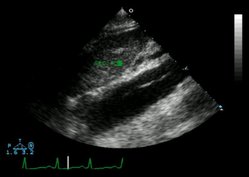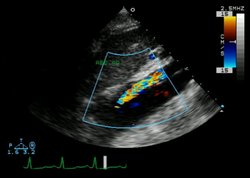Definition
Aortic dissection is a rare, but potentially fatal, condition in which blood passes through the inner lining and between the layers of the aorta. The dissecting aorta usually does not burst, but has an abnormal second channel within it.
Description
A defect in the inner lining of the aorta allows an opening or tear to develop. The aorta is the main artery of the body and is an area of high blood pressure. When a defect develops, blood pressure can force the tear to open and allow blood to pass through. Since the blood is under pressure, it eventually splits (dissecting) the middle layer of the blood vessel, creating a new channel for blood. The length of the channel grows over time and can result in the closing off of connection points to other arteries. This can lead to heart attack, strokes, abdominal pain, and nerve damage. Blood may leak from the dissection and collect in the chest an around the heart.
A second mechanism leading to aortic dissection is medial hemorrhage. A medial hemorrhage occurs in the middle layer of the blood vessel and spills through the inner lining of the aorta wall. This opening then allows blood from the aorta to enter the vessel wall and begin a dissection. Approximately 2,000 cases of aortic dissection occur yearly in the United States.
Causes & symptoms
Aortic dissection is caused by a deterioration of the inner lining of the aorta. There are a number of conditions that predispose a person to develop defects of the inner lining, including high blood pressure, Marfan's disease, Ehlers-Danlos syndrome, connective tissue diseases, and defects of heart development which begin during fetal development. A dissection can also occur accidentally following insertion of a catheter, trauma, or surgery. The main symptom is sudden, intense pain. The pain can be so intense as to immobilize the patient and cause him to fall to the ground. The pain is frequently felt in both the chest and in the back, between the shoulder blades. The extent of the pain is proportional to the length of the dissection.
Diagnosis
The pain experienced by the patient is the first symptom of aortic dissection and is unique. The pain is usually described by the patient as "tearing, ripping, or stabbing." This is in contrast to the pain associated with heart attacks. The patient frequently has a reduced or absent pulse in the extremities. A murmur may be heard if the dissection is close to the heart. An enlarged aorta will usually appear in the chest x rays and ultrasound exams of most patients. The use of a blood dye in angiograms and/or CT scans (computed tomography scans) will aid in diagnosing and visualizing the dissection.
Treatment
Because of the potentially fatal nature of aortic dissection, patients are treated immediately. Drugs are administered to reduce the blood pressure and heart rate. If the dissection is small, drug therapy alone may be used. In other cases, surgery is performed. In surgery, damaged sections of the aorta are removed and a synthetic graft is often used to reconstruct the damaged vessel.
Prognosis
Depending on the nature and extent of the dissection, death can occur within a few hours of the start of a dissection. Approximately 75% of untreated people die within two weeks of the start of a dissection. Of those who are treated, 40% survive more than 10 years. Patients are usually given long term treatment with drugs to reduce their blood pressure, even if they have had surgery.
Key Terms
- Dissection
- A cut or divide.
- Hemorrhage
- A large discharge of blood, profuse bleeding.
Further Reading
For Your Information
Books
- Alexander, R.W., R. C. Schlant, and V. Fuster, eds. The Heart, 9th ed. New York: McGraw-Hill, 1998.
- Berkow, Robert, ed. Merck Manual of Medical Information. Whitehouse Station, NJ: Merck Research Laboratories, 1997.
- Braunwald, E. Heart Disease. Philadelphia: W.B. Saunders Company, 1997.
Gale Encyclopedia of Medicine. Gale Research, 1999.




